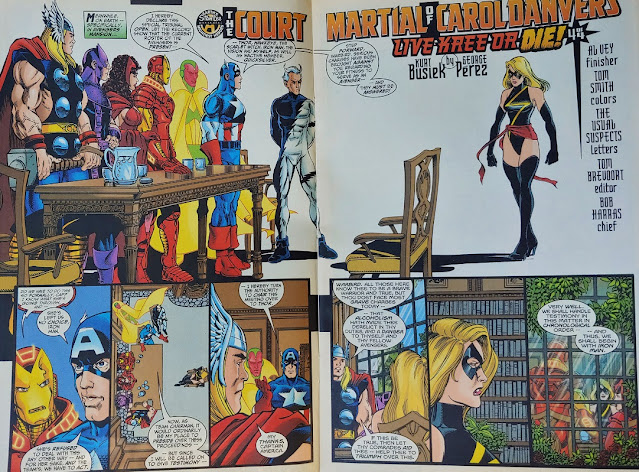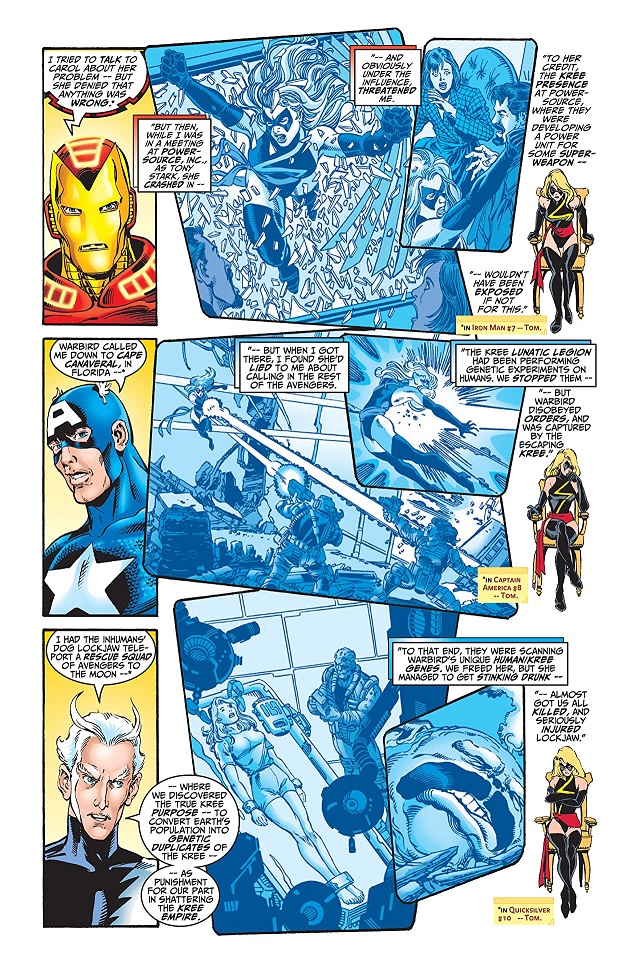Years ago, when I first traveled to the US, I visited relatives in New Jersey. I found The Avengers # 27 in a newsstand, and when I bought it I became a fan. There is a reason why, through the years, I kept tracking down all the Avengers issues from the Busiek and Pérez run, which is not only my favorite but also one of the best regarded ever.
Because I could only buy some random issues here and there, in the very few comic book shops I used to go to in Lima, my Avengers collection was actually quite small. So when I got the third part of the “Live Kree or Die” saga I hadn’t read what had happened before, but I understood in a second the real relevance of “The Court Martial of Carol Danvers” (published in The Avengers # 7, August 1998).
Carol Danvers (AKA Warbird, and nowadays Captain Marvel) is under trial. Judged by her own colleagues, she must defend herself. Thor is appointed as the most impartial member of the committee, and he says: “All those here know thee to be a brave warrior and true, but thou dost face most grave charges today -- that alcoholism hath made thee derelict in thy duties, and a danger to thyself and thy fellow Avengers. If this be true, then let thy comrades aid thee -- help thee to triumph over this”. Carol has no answer, but her facial expression communicates anger and frustration.
As Earth’s mightiest heroes, the Avengers save the world on a weekly basis, fight against hundreds of villains, aliens and cosmic forces beyond human imagination. But can they fight against an addiction? Can they help one of their members to overcome alcoholism? One by one, all the Avengers testify, starting with Iron Man, who remembers how he was hesitant on offering a membership to Carol due to the possibility of her being an alcoholic, as was seen in “Too Many Avengers!”.
 |
| The Avengers # 4 & 5 |
When it’s the turn of Wanda Maximoff (AKA Scarlet Witch), she decides not to mention the drinking incident that took place in “Earth’s Mightiest Frauds?”, but she remembers how much it broke her heart to see Carol Danvers departing in such a traumatic way in “By Friends --Betrayed!”. Wanda is aware of how much the Avengers failed Carol when she needed them the most. When Wanda begs her friend to find help, Carol finally breaks down. This strong, powerful and proud woman, who just seconds ago had been screaming at Thor and Captain America, cannot stop crying. When faced with accusations, Carol does her best to defend herself, but when she is faced by Wanda’s honest concern, she cannot do anything but cry.
Warbird is no longer a member of the Avengers, and Wanda is the only one who cries because of this. The whole team then quickly goes to the moon, to fight against a group of alien mercenaries and to find the Supreme Intelligence of the Kree. Despite the court martial and all the humiliation she has endured, Carol Danvers decides to fly to the moon to help her former teammates. In the past, she was powerful enough to fly to another galaxy if she wanted to, but months of heavy drinking have severely limited her capabilities. “The woman called Warbird forges ahead -- drawing on her internal power reserves, closing off her need to breath -- forcing herself forward […] Warbird’s diminished power reaches its limits, and she convulses -- convulses and begins to fall”. Busiek’s dramatic lines combined with Pérez’s extraordinary art turn this into one of the most unforgettable moments in the history of the Avengers. Because in the end, it doesn’t matter how powerful our heroes can be, or how many victories they may have under their belts, what matters is their courage and their refusal to surrender. Carol Danvers doesn’t give up until her body betrays her. She falls down to Earth, against her will, and after landing she feels as if she has failed.
There are no happy endings in this story. Carol Danvers doesn’t miraculously recover from her alcoholism. The Avengers don’t invite her to be part of the team again. Carol Danvers isn’t defeated by the Kree aliens or by any external threat, she’s defeated by her own addictions. And when she proclaims, in tears, that she needs a drink, as readers we can understand her pain. The last page is, in my opinion, one of the best endings I’ve ever seen in a superhero comic book. Carol is in the same bar she always goes to, and she has a glass of whisky in front of her. Somebody asks if she is going to drink it. She holds the glass, with a defeated look on her face, and answers “I don’t know”.
________________________________________________________________________________________________________
________________________________________________________________________________________________________
Hace años, cuando viajé por primera vez a Estados Unidos, visité a familiares en New Jersey. Allí encontré The Avengers # 27 en un quiosco, y cuando lo compré me convertí en un fan. Hay una razón por la que, a lo largo de los años, seguí rastreando todos los números de los Avengers de la etapa de Busiek y Pérez, que no sólo es mi favorita, sino también una de las más celebradas de la historia.
Debido a que sólo podía comprar algunos números al azar aquí y allá, en las pocas tiendas de cómics a las que solía ir en Lima, mi colección de los Avengers era bastante pequeña. Así que cuando adquirí la tercera parte de la saga “Vive Kree o muere” no había leído lo que había pasado antes, pero comprendí en un segundo la verdadera relevancia de “La corte marcial de Carol Danvers” (publicado en The Avengers # 7, agosto de 1998).
Carol Danvers (alias Warbird, y hoy Capitana Marvel) está bajo juicio. Juzgada por sus propios colegas, debe defenderse. Thor es designado como el miembro más imparcial del comité y dice: "Todos aquellos que aquí están os conocen como una guerrera valiente y leal, pero hoy os enfrentais a los cargos más graves: que el alcoholismo os ha vuelto negligente en vuestros deberes, y un peligro para vos misma y vuestros compañeros Vengadores. Si acaso esto sea cierto, entonces dejad que vuestros camaradas os ayuden -- os ayuden a salir triunfante”. Carol no tiene respuesta, pero su expresión facial transmite ira y frustración.
Como los héroes más poderosos de la Tierra, los Vengadores salvan el mundo semanalmente, luchan contra cientos de villanos, alienígenas y fuerzas cósmicas más allá de la imaginación humana. Pero, ¿pueden luchar contra una adicción? ¿Pueden ayudar a uno de sus miembros a superar el alcoholismo? Uno por uno, todos los Vengadores testifican, comenzando por Iron Man, quien recuerda cómo dudaba al ofrecer una membresía a Carol debido a la posibilidad de que ella fuera alcohólica, como se vio en “¡Demasiados Vengadores!”.
 |
| Carol needs alcohol again / Carol necesita alcohol de nuevo |
Cuando le toca el turno a Wanda Maximoff (también conocida como la Bruja Escarlata), decide no mencionar el incidente con la bebida que tuvo lugar en “¿Los fraudes más poderosos de la Tierra?”, Pero recuerda que se le rompió el corazón al ver a Carol Danvers partir en una situación tan traumática en "Traicionada por amigos". Wanda es consciente de cuánto le fallaron los Vengadores a Carol cuando más los necesitaba. Cuando Wanda le ruega a su amiga que busque ayuda, Carol finalmente se derrumba. Esta mujer fuerte, poderosa y orgullosa, que hace apenas unos segundos le había estado gritando a Thor y al Capitán América, no puede dejar de llorar. Cuando se enfrenta a las acusaciones, Carol hace todo lo posible por defenderse, pero cuando se enfrenta a la honesta preocupación de Wanda, no puede hacer nada más que llorar.
Warbird ya no es miembro de los Vengadores, y Wanda es la única que llora por esto. Luego, todo el equipo va rápidamente a la luna, para luchar contra un grupo de mercenarios alienígenas y encontrar la Inteligencia Suprema de los Kree. A pesar del consejo de guerra y toda la humillación que ha sufrido, Carol Danvers decide volar a la luna para ayudar a sus excompañeros. En el pasado, era lo suficientemente poderosa como para volar a otra galaxia si quería, pero meses de beber en exceso han limitado gravemente sus capacidades. “La mujer llamada Warbird avanza - alimentándose de sus reservas de energía internas, eliminando su necesidad de respirar - forzándose hacia adelante [...] El poder disminuido de Warbird alcanza sus límites, y ella convulsiona - convulsiona y comienza a caer”. Las líneas dramáticas de Busiek combinadas con el extraordinario arte de Pérez convierten este en uno de los momentos más inolvidables en la historia de los Vengadores. Porque al final, no importa cuán poderosos puedan ser nuestros héroes, o cuántas victorias puedan tener en su haber, lo que importa es su coraje y su negativa a rendirse. Carol Danvers no se rinde hasta que su cuerpo la traiciona. Ella cae a la Tierra, contra su voluntad, y después del duro aterrizaje siente que ha fracasado.
No hay finales felices en esta historia. Carol Danvers no se recupera milagrosamente de su alcoholismo. Los Vengadores no la invitan a volver a formar parte del equipo. Carol Danvers no es derrotada por los extraterrestres Kree ni por ninguna amenaza externa, es derrotada por sus propias adicciones. Y cuando ella proclama, entre lágrimas, que necesita un trago, como lectores podemos entender su dolor. La última página es, en mi opinión, uno de los mejores finales que he visto en un cómic de superhéroes. Carol está en el mismo bar al que siempre va y tiene un vaso de whisky frente a ella. Alguien le pregunta si se lo va a beber. Ella sostiene el vaso, con una mirada de derrota en el rostro, y responde “No lo sé”.
























